|
Baseball Vignettes – III
|
Durocher on Mays
Leo "The Lip" Durocher was the manager of the New York Giants when Willie Mays came to the National League during the 1951 season.
- Eddie Montague, a Giants scout, went to Birmingham AL to look at a Negro 1B. He came back enthused about the centerfielder who was "the best ballplayer I ever looked at. You better send somebody down there with a barrelful of money and grab this kid."
- The Giants bought Mays for $13,000 and sent the 19-year-old to Trenton in the Interstate League for the 1950 season. A minor league scout gave Durocher the same glowing report that Montague had given.
- As a result, Leo wanted Willie in the Giants 1951 spring training camp. However, the front office said he wasn't ready. After watching the kid perform in a spring game for AAA Minneapolis, The Lip asked owner Horace Stoneham to move Mays to the Giants. Stoneham replied that the phenom was due to go into the service soon. (The Korean War caused the reinstatement of the draft.)
After 35 games at Minneapolis, Mays was hitting .477. Meanwhile, the Giants were 13-15, in fifth place, 4.5 games out of first.
- Willie joined Leo's club on May 25 in Philadelphia. Durocher described what happened in his autobiography Nice Guys Finish Last.
The Philadelphia ball club was warming up on the sidelines getting ready to take infield practice when Willie stepped into the batting cage for the first time, and every player there stopped dead in his tracks and watched him. He hit balls on top of the roof, into the upper deck, the lower deck, all over the park, and everything he hit was a screamer.
- Adds Leo, "The only trouble was that he didn't hit in the game."
- Contrary to Durocher's famous story, which says Willie went hitless in his first 24 ABs, Mays went 0-for-12 in Philly before the Giants returned to New York to face the Boston Braves.
- "After the last of the hitless games, which we lost, 1-0 [the Giants actually won the third game in Philly, 2-0], I went back into my office, kicked off my shoes and contemplated the various ways of committing suicide."
- Two of Leo's coaches interrupted his reverie to tell him, "You better do something about your boy. He's in front of his locker, crying."
- Leo hurried to Willie and engaged in one of the most famous dialogs in baseball history.
What's the matter, son?
Mis-a-Leo, I can't help you. I can't even get a hit. I know I can't play up here, and you're gonna send me back to Minneapolis.
Look, son. I brought you up here to do one thing. That's to play CF. You're the best CFer I've ever looked at. As long as I'm here, Willie, you're going to play CF. Tomorrow, next week, next month ... Go home and get a good night's sleep. Tomorrow is another day.
- In his first game in the Polo Grounds, facing future Hall of Famer Warren Spahn, Mays homered in his first AB but finished the game 1-for-4.
- Willie then went hitless in the next three games to make him 1-for-24. Leo placed the HR off Spahn at this point, which makes the story more dramatic but not quite correct. The dialog above may well have occurred when Willie was 1-for-24, not 0-for-12.
- At any rate, dropped to the eighth spot in the order, Mays went 2-for-4 (single and triple) on June 2 against the last place Pirates.
- The next game, against St. Louis, Mays batted seventh and hit two doubles in three AB.
- By the end of the season, Willie raised his BA to .274 with 20 HR and 68 RBI.
- The Giants, of course, came from 13 1/2 games behind to catch the Dodgers and beat them in the two-out-of-three playoff on Bobby Thomson's famous HR. (Read about the playoff ...)
- Through it all, Mays played CF better than anyone ever has. He won the NL Rookie of the Year Award in a landslide.
The Giant players took to Mays instantly. " Willie was not only the star of the team, he was everybody's pet," says Leo.
He'd take out his pocketbook in the bus and, in his high, piping voice, he'd say, "Man, I'm empty." Then he'd hand it to the guy behind him and say, "Boys, put a little somp'n in." Well, they'd spit in it and put cigarette butts in it, and by the time it came back around to him, there'd be three pennies and an indescribable mess. Willie would look in happily, and with that big sunny smile of his he'd say, "Ev'y little bit helps."
- Willie had what Leo calls "magnetism ... which infects everybody around them with the feeling that this is the man who will carry them to victory. Babe Ruth had it, and so did Dizzy Dean, Jackie Robinson and Pepper Martin ... And what made [Willie] even more appealing was that he didn't know it."
|
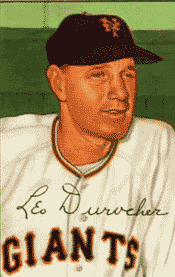 Leo Durocher
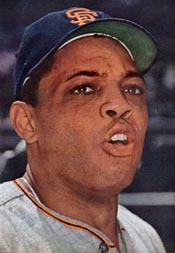
Willie Mays
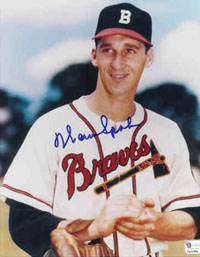
Warren Spahn
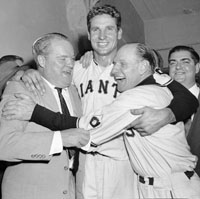
Horace Stoneham, Bobby Thomson,
and Leo Durocher exult after
Thomson's HR won the 1951 pennant. |
Dusty Rhodes, the New York Giants hero in the 1954 World Series, had a drinking problem.
- Following the '53 season, which was Dusty's second in the NL, the Giants went on a goodwill tour of Japan. They arrived in Tokyo on a Thursday and were scheduled to play their first game on Friday.
- Durocher found Dusty in the hotel lobby Friday morning barely able to stand. "Where the hell have you been?" the skipper demanded. "Was over to shee my shister," slobbered Rhodes. Leo thought, "Yeh, sure." "The bus leaves in a couple of minutes. Be on it!"
- Leo: "I put him right into the starting lineup and sat back to watch him suffer." Dusty "suffered" to the tune of several HRs.
- After the game, Durocher made a beeline to owner Horace Stoneham's suite to demand that he get rid of Rhodes. Only one problem - Dusty was already there having a drink with the boss. After Leo got his miscreant out of there, he made his pitch. "He's a rotten apple." When Horace demurred, The Lip went a step further. "It's Durocher or Rhodes, make up your mind. I don't want him on this club!"
- The Giants tried to trade Rhodes, but his reputation preceded him and no other team would touch him, not even for the $1 waiver price.
So the guy Leo was stuck with had the greatest year a pinch hitter ever had.
- Whenever the manager would need a key hit, Dusty would pipe up in his Southern drawl: "What are you waiting on, Skip? Ah'm your man!"
- In only 164 ABs, Rhodes hit .341, smacked 15 HRs, and drove in 50.
- "Before the summer was out, I was leading him around the bars and buying his whisky," says Leo.
Training rules? They were forgotten where Dusty Rhodes was concerned. He never took another player with him, and he never lied to me. If I asked him what time he had got in, and he had got in at four o'clock, he'd tell me four o'clock. And he was always the first one dressed the next day and ready to play. In addition to everything else, he was the kind of buffoon who kept a club confident and happy.
- In the four-game sweep of the Indians in the World Series, Dusty hit a walkoff HR in Game One, drilled a game-tying single and a home run that added an insurance run in Game Two, and swatted a two-run single in Game Three.
Durocher remembered one game in particular when Dusty bailed him out.
- The Giants played the Dodgers on June 29 before 51,464 at the Polo Grounds. Brooklyn scored in the top of the 13th to take a 3-2 lead.
- New York loaded the bases against Billy Loes with two outs. C Ray Katt was due up. Since Katt had taken over for starter Wes Westrum when the latter was lifted for a PR earlier in the game, Durocher had no other C should the game go another inning.
- Nevertheless, Leo called for Dusty which brought protests from the coaches. "You can't do that, Leo. You have no C." To which Rhodes replied, "He don't need a C. Don't worry about it. I'll win it right here." The manager threatened his PH with a $200 fine if he walked or got hit by a pitch.
- On the second pitch, Dusty hit a bullet to CF to score two and win the ball game.
- Reporters were all over Leo. What would have happened if he'd walked or got hit? You'd have no C - did you think of that? Leo explained: "I'd rather be in the 14th inning without a C than in the clubhouse with a loss. Once I'm in the clubhouse, I can't win it. As long as I'm out on that green stuff out there, I'll find somebody to catch."
P.S. from Leo: "I learned later that Dusty did have a sister in Japan. She was married to a serviceman who was stationed there."
|
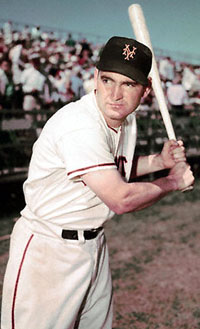 Dusty Rhodes
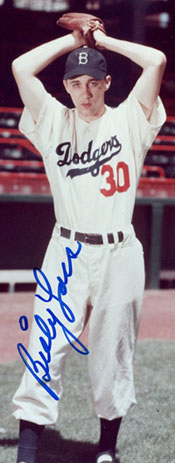 Billy Loes
|
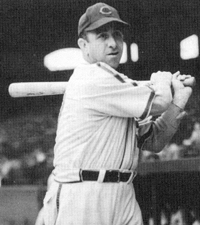
Tony Cuccinello

Snuffy Stirnweiss
|
Scorer Shenanigans
Several batting championships have been determined by questionable scoring decisions.
AL 1945
- In the final year of World War II, Tony Cuccinello of the White Sox led Snuffy Stirnweiss of the Yankees by .002 entering the final day of play.
- The White Sox doubleheader was rained out, giving Snuffy a clear path to the crown. He went 3-for-5 against the Red Sox at Yankee Stadium to finish first by .308544 to .308457, the closest margin in history. (In fact, Chicago played only one game the final week of the season, leaving them six short of the scheduled 154.)
- However, in his second AB, Snuffy hit a ball that was booted and thrown away by 3B Jack Tobin. The official scorer, Harry Gumpert, who was a writer from the Bronx Home News, reversed his decision after learning that the White Sox had been cancelled.
- When Tony later coached Stirnweiss with the Indians, Snuffy told him: "He (the scorer) gave it to me." Tony also heard that New York writer Dan Daniel proclaimed, "We don't want a National Leaguer leading the American League." This referred to the fact that Cuccinello spent his first 12 seasons in the NL.
AL 1953
- In this season, the scorer's decision took place August 12 when the Senators hosted the Yankees.
- Washington 1B Mickey Vernon smacked a grounder to SS Phil Rizzuto, who booted it. Official scorer Bob Addie, a local sportswriter, called the play an error. However, the next day, 2B umpire Art Passarella told him the ball took a bad hop. So Addie changed the call to a hit.
- Vernon battled Cleveland's Al Rosen for the batting title to the last game of the season. Near the end of the game, Vernon's average was .337 when word arrived that the Indians' game was over and Rosen trailed Vernon by .0011. The possibility of Vernon coming up to bat again and possibly losing the title caused his teammates to purposely make outs to end the game. Mickey's second batting title - the other was in 1946 - kept Rosen from winning the Triple Crown.
- Some writers have questioned whether the players conspired against Rosen because he was Jewish. Al did win the AL MVP award that year.
Reference: "Stat Men," Craig Tapper, Yankees Magazine, July 2011 |
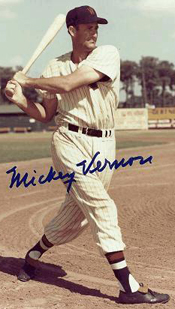
Mickey Vernon
 Al Rosen |
|
The "Real" 1944 World Series
In September 1944, the Army and Navy staged a military service championship in Hawaii. Locals called it the "real World Series."
- The "World's Baseball Championship" came about when a survey by the War Department found that, of the 350-plus major leaguers in the military, 280 were stationed in the U.S., and many of those overses were playing ball. Embarrassed, Chief of Staff General George Marshall ordered their dispersal overseas.
- The Navy, more so than the Army, gathered as many major leaguers for its roster as possible. For example, Dom DiMaggio, Red Sox CF, and Phil Rizzuto, Yankee SS, both of whom had played for the Norfolk Naval Station team, were flown in from Australia. Johnny Vander Meer, double no-hit P for the Reds, was brought to Honolulu from the Sampson Naval Training Center in New York State.
Not surprisingly, the Navy, managed by future Hall of Famer Bill Dickey of the Yankees, won eight games while the Army, under the direction of Lt. Tom Winsett, formerly of the Dodgers and Senators, captured only two while one contest ended in a tie.
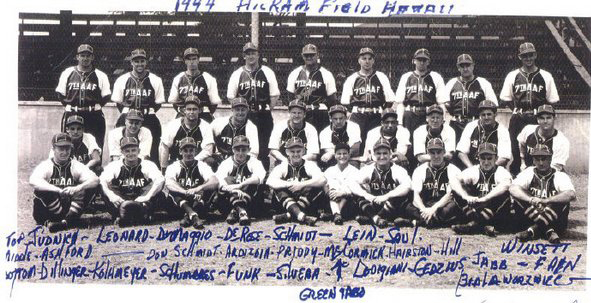 Army Team in 1944 "World's Baseball Championship"
- Game One (September 22 at Furlong Field): The Bluejackets won 2-0 behind the four-hit pitching of Virgil Trucks of the Tigers. Johnny Beazley of the Cardinals started for the Army. Rizzuto went 3-for-3. Joe Gordon,Yankee 2B, played SS for the Army and made the play of the day, grabbing a line drive, stepping on second, and throwing to first to complete a triple play.
- Game Two (September 23 at Hickam Field): Joe Grace, St. Louis Browns OF, hit a grand-slam in the ninth inning as the Navy romped, 8-2. Vander Meer scattered seven hits.
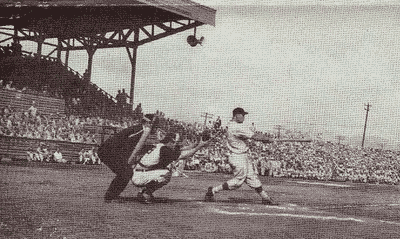 Joe Gordon strikes out to end Game Two.
- Game Three (September 25 at Redlander Field): Before a crowd of 14,000, the Army started Don Schmidt, a semipro hurler, who kept the Navy at bay more than the pros who pitched in the preceding games. Don surrendered only six hits and struck out nine. Johnny Mize of the Giants singled in Barney McCosky, Detroit OF, and Grace to give the Navy two runs in the first inning. A HR by Walter Judnich of the Brownsproduced the Army's first run in the second, and singles by Bob Dillinger of the Toledo Mud Hens, Judnich, and Mike McCormick of Cincinnati put the Army ahead in the third. Vince Smith of the Pirates, however, singled the Browns' Johnny Lucadello home with the tying run in the fourth. There was no further scoring until the twelfth when Yankee C Ken Sears's four-bagger produced a 4-3 victory.
- Game Four (September 26 at Kaneohe Bay NAS): 10,000 watched the Navy jump out to an early lead to win 10-5. Mize poled a 360' HR in the first off Beazley to score McClosky ahead of him. The Army finally plated five in the sixth as Ferris Fain of the San Francisco Seals and Gordon homered, knocking out Trucks and bringing Schoolboy Rowe of the Phillies to restore order. Sammy Hairston from the Negro leagues finished on the mound for the Army.
- Game Five (September 28 at Furlong Field): The Navy made it five straight, belting the ground forces 12-2 in front of 15,000. Vander Meer gave up only five safeties to cop his second victory of the series. The Navy clinched the game with 10 in the fourth. Hairston finished out the inning.
- Game Six (September 30 at Hickam Field): Tom Ferrick of the Red Sox won in relief 6-4 as the Navy stretched its victory string to six. Jack Hallett, Pirates hurler, started before giving way in the fourth to Walt Masterson of the Senators. Don Schmidt pitched for the losers and was touched for 11 hits. Gordon hit a two-run HR in the third. With the score tied at 4 in the eighth, Ferrick helped his own cause by singling in Rowe, who was playing LF. Rizzuto then squeezed Dodger SS Pee Wee Reese home with an insurance run.
- Game Seven (October 1 at Hickam Field): The Army finally prevailed, 5-3, despite garnering only six hits off Trucks. HRs by Yankees farmhand Don Lang in the second, Dillinger in the sixth with Bill DeCarlo of the Minneapolis Millers on base, and Fain in the ninth, with Judnich resting on first, accounted for all Army runs. Trucks doubled home Reese in the second. Singles by Joe DiMaggio (who had not played many games in the Series because of ulcers), Al Brancato of the Athletics and Eddie Shokes of the Reds, sandwiched between DiMaggio's stolen base and Reese's W, tallied a brace of runs for the Tars in the third. Bill Schmidt, former Sacramento P, was credited with the victory.
- Game Eight (October 4 at Maui): The Navy returned to its winning ways, 11-0, behind the pitching of Hallett. The Bluejackets mauled Army pitchers for 14 hits.
- Game Nine (October 5 at Maui): Winslet's men rebounded for a 6-5 victory despite being outhit 10-5. Navy took a 4-0 lead but surrendered it in the late innings on a combination of Vander Meer's wildness and errors. Gordon scored the winning run in the ninth on a wild throw by Brancato.
- Game Ten (October 6 at Hilo): This one ended in a 6-6 standoff as darkness ended the contest after 14 innings. Rowe's HR gave the Navy a lead in the top of the 12th but C Charlie Silvera, a Yankee farmhand at Kansas City, reciprocated in the bottom of the inning.
- Game Eleven (October 15 at Kukuiolono Park): The Bluejackets prevailed 6-5 in the final game of the series.
Following the Army-Navy World Championship, many of the players – including Trucks, Vander Meer, Reese, Mickey Vernon, and Gene Woodling – stayed in Hawaii and formed all-star teams that toured the Pacific entertaining sailors and soldiers for the remainder of the war.
Reference: baseballinwartime.blogspot.com
|
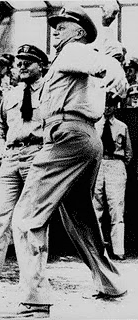
Admiral Nimitz throws out the first ball of the series.
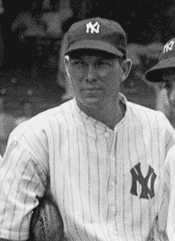
Bill Dickey

Dom and Joe DiMaggio
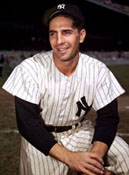
Phil Rizzuto
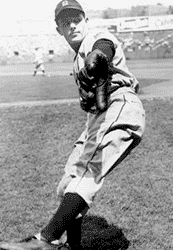
Virgil Trucks
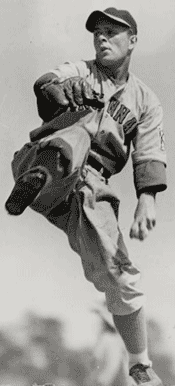
Johnny Vander Meer
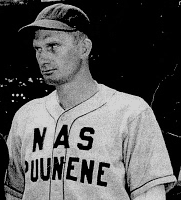 Jack Hallett |
|
Wacky Waddell
Without doubt, the most colorful (flaky, wacky, daft, kookie) character in baseball
history was George "Rube" Waddell. He was a talented southpaw who won 20 games for four straight seasons (1902-5) and led the American League in strikeouts six years in a row. Included was a 349 K performance in 1904 that set a record that stood for sixty years until broken by Sandy Koufax. Like Sandy, Rube had an overpowering fastball and a devastating curve.
However, the well-nicknamed Rube drove every one of his managers crazy, including future Hall of Famer Connie Mack. Mack had the most success with him by treating him as the overgrown child that he was. Here's a sampling of Waddell's antics.
- He sometimes turned cartwheels on his way to the mound. More than once he left the mound in the middle of a game to chase after firetrucks.
- In a spring training game, he waved his outfielders from the field
and then struck out the side. Unable to do that in the regular season because the rules require nine men on the field, he had his outfielders sit down on the fringe of the infield. He then fanned three in a row.
- 1903 was an outstanding year for Waddell. He won 21 games and led the league in strikeouts with 302. All this despite not showing up until June! That year he also toured in a vaudeville play, led a marching band through Jacksonville, got married and separated (at least he wasn't married to two women at the same time – that was a different year), rescued a log from drowning (he thought it was a woman), accidentally shot a friend (long before Dick Cheney), and was bitten by a lion.
- Once Rube pitched a 17-inning victory in the opening game of a doubleheader. Mack offered him an enticement to pitch the second game – a fishing trip. Waddell pitched a shutout.
- Rube sometimes disappeared for days or even weeks. He was also lost for the September stretch run and World Series of 1905 after he injured
his shoulder in an altercation with a teammate. (More about this in a future Vignette.)
- The southpaw (or "sousepaw" as Cait Murphy calls him) arrived late for many games, often because he had been playing marbles with neighborhood kids.
- Once on an off day in Washington, Mack was visiting friends when a fire engine pulled up in front of a nearby burning building. Watching the crew work, Connie was struck by a fireman risking his life pouring water through a second-floor window. Mack soon realized the courageous lad was none other than Rube Waddell!
- Waddell often pitched drunk. This was tolerated because he usually succeeded quite well in his inebriated state, which affected his fielding more than his hurling (the kind you do on the mound not in the bathroom).
- Because of Rube's drinking and carousing, Mack hired a private detective to keep him from disappearing from the team. "He's got a million-dollar arm and a two-cent head," said an exasperated Connie. He took to doling out Rube's $2,500 salary to him in $10 allowances.
- Rube's road roommate was catcher Ossie Schreckengost who hated Waddell's habit of eating Limburger cheese sandwiches and crackers. Schreck refused to sign his 1903 contract until Mack added a clause that forbade Rube from eating cheese and crackers in bed.
Reference: Baseball Eccentrics, Bill "Spaceman" Lee
|
|
Lost Home Runs
With all the hoopla surrounding Barry Bonds breaking Hank
Aaron's HR record, it is fitting to recall that Babe Ruth and Aaron each lost at least one HR to the rules of the era or an umpire's judgment.
- On July 9, 1918, the Cleveland Indians visited the Boston Red Sox at Fenway Park. Ruth came up in the bottom of the tenth of a scoreless game with Amos Strunk on first
with a single. Babe clouted a drive into the RF bleachers. However, the rules of that day said that the game ended as soon as the winning run crossed the plate. So the Bambino was credited with only enough bases to drive the run home - in this
case, a triple. (If Strunk had been on third, Babe
would have been credited with only a single.)
- Rule 6.03 says, "The batter's legal position shall be with both feet within the batter's box." On August 18, 1965, at Sportsman Park in St. Louis, Aaron (then with the Milwaukee
Braves) walked up on a blooper pitch from Curt Simmons of the Cardinals and swatted it over the fence. However, home plate umpire Chris Pelekoudas ruled the HR illegal because Hank
was out of the batter's box when he hit the ball. So Aaron
was called out on the play. However, if he had missed the pitch, he
would not have been out.
Reference:
The Rules and Lore of Baseball, Rich Marazzi
|
|
Scooter Comes Through
Phil Rizzuto died August 20, 2007. Two plays in 1951 were symbolic of " The Scooter's" career and show his value to his team, the New York Yankees.
We'll talk about the first one here and the other one in the next Vignette.
Rizzuto, a right-handed batter, faced right-hander Bob Lemon of the Cleveland Indians in the bottom of the ninth inning in the middle of the pennant race. The score was tied at 1. Joe DiMaggio was on third base. Rizzuto took Lemon's first pitch for a strike. He argued the call with the umpire as a cover to grab the bat from both ends, giving the sign to DiMaggio that a squeeze play was on for the next pitch. But DiMaggio broke early, surprising Rizzuto. Lemon, seeing what was happening, threw high, aiming behind Rizzuto. But with Joe bearing down on him, Rizzuto got his bat up in time to lay down a bunt. DiMaggio scored the winning run.
"If I didn't bunt, the pitch would've hit me right in the head," Rizzuto said. "I bunted it with both feet off the ground, but I got it off toward first base." Yankee manager Casey Stengel called it "the greatest play I ever saw." |
|
Scooter's Biggest Embarrassment
This is the second of Phil Rizzuto's signature plays for the Yankees.
Polo Grounds, Game 3 of the 1951 World Series: Yankees
vs the New York Giants,
who had just won the National League on Bobby Thomson's
dramatic HR in the third playoff game against the Dodgers.
This game provided Rizzuto with perhaps his most embarrassing
moment on the ballfield.
With one out in the fifth inning, the Giants' Eddie Stanky drew a walk from Vic Raschi.
The next batter was Alvin Dark, and the Yankees
intercepted a hit-and-run sign. C Yogi Berra signaled
a pitchout, and his throw to Rizzuto at second base
beat Stanky by ten feet. But the sliding Stanky
kicked the ball out of Phil's glove into center field.
Stanky continued to third on Rizzuto's
error. The Giants scored
five unearned runs in the inning on their way to a 6-2 victory to take
a 2-1 series lead. However, the Yankees
took the next three games to win the third of what would be five consecutive
World Championships.
"I was nonchalanting it," Rizzuto admitted
sheepishly. "I was looking at the TV camera." |
|
Fastest Pitcher Ever
Steve Dalkowski was a left-handed pitcher in the minor leagues, mostly in the Orioles system, from 1957-1966. More than one observer, including Ted Williams, has called Steve the fastest pitcher they ever saw.
- Some scouts think Dalkowski threw over 100 mph. Some said
as high as 110 but most peg him in the 105 range. However, he could
not control his stuff.
- In high school in Connecticut, Dalkowski struck out
18 in a game, allowing no hits and no runs. However, he also walked
18 batters.
- In his first professional season (1957), he pitched 62 innings for Kingsport in Class D. He struck out 121, which is an average of 18 per game. However, he won only one game because he walked 129 and threw 39 wild pitches.
- On August 31, 1957, he struck out 24 Bluefield batters.
But 18 walks, six wild pitches, and 4 HBPs contributed to an 8-4 defeat.
- Steve struck out $104,000 bonus baby Rick Monday four times in a game. Monday, of course, had a long major league career. Dalkowski never made it to the big show.
- Earl Weaver was his manager in Elmira NY. An IQ test given to all the players revealed that Steve was below average. So Earl kept things simple: just throw fastballs
and sliders. Aim the fastball down the middle; if it moves, it may catch the corner. Under this regimen, Steve had his best season in 1962, winning seven and losing 10 with a 3.04 ERA. In 160 innings, he struck out 192 and walked "only" 114.
- Orioles CF Paul Blair said of Dalkowski: "He threw the hardest I ever saw. He was the wildest I ever saw." Ted Williams faced Steve in a spring training game. "Fastest ever. I never want to face him again."
Alcoholism killed any chance Dalkowski had of getting his act
together and reaching the big leagues. Eventually, he hurt his pitching elbow in the spring of 1963 while in the Orioles camp and lost 15 mph on his fastball. Released by Baltimore in 1964, he played two more season in the Pirates and Angels organizations. His lifetime statistics: 46-80 record, 5.59 ERA, 1396K, 1354W in 995 innings.
Reference: Baseball Eccentrics, Bill "Spaceman" Lee |
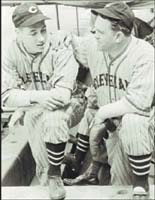
Bob Feller with Manager Steve O'Neill
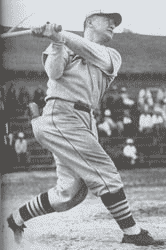
Frankie Frisch
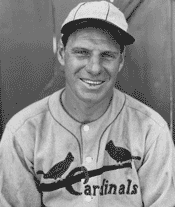
Leo Durocher
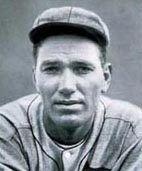
Dizzy Dean
|
The Fuss over Feller - I
It's safe to say that no 17-year-old ever caused a bigger sensation in professional baseball than Bob Feller.
- On July 22, 1935, while he was still in high school, the farm boy from Van Meter IA signed a contract with the Fargo-Moorhead club of the Northern League. (Actually, his father signed the contract since Bob was only 16.) The team did not expect Feller to pitch for them. The signing was part of a plan to skirt existing rules so that the Cleveland Indians could acquire the pitching phenom, whose fastball was rumored to reach 100 mph.
- The following year, Fargo-Moorhead transferred his contract to New Orleans, another Cleveland affiliate. Again, Bob didn't throw a pitch for the Pelicans.
- In July, 1936, New Orleans dutifully transferred Bob's contract to Cleveland so that Feller could pitch in an exhibition game against the St. Louis Cardinals during the All-Star break.
10,000 Indians fans turned out to see for themselves what the hubbub over the teenage P was all about.
- Feller took the mound in the fourth inning. Indians manager Steve O'Neill, a former C celebrating his 45th birthday, decided to put on the tools of ignorance to get the best view of Feller's stuff. He told the boy to throw only fastballs.
- One of Feller's warm-up pitches sailed over the C and thudded against the backstop. That caused Cardinals player-manager Frankie Frisch to take himself out of the lineup. He turned to rookie OF Lynn King and asked, "Ever play second base?" "No." "Well, you are today, kid. I'm getting too old to get killed in the line of duty."
- The first batter Feller faced was C Bruce Ogrodowski. Here's an excerpt from Feller's autobiography Now Pitching - Bob Feller:
My first pitch to Ogrodowski was a called strike, and it made something of a smacking sound as it hit O'Neill's mitt. Ogrodowski turned to O'Neill and said, 'Let me out of here in one piece.' He was serious and he laid the next pitch down, bunting down the third-base line.
- Feller struck out the next two batters, Leo Durocher and Art Garibaldi.
- Bob began the fifth by whiffing P Les Munns, then gave up a run on a single, a walk, a double steal, and a wild pitch. He ended the uprising by fanning Pepper Martin and Ripper Collins, two of the Redbirds' best hitters.
- Ogrodowski led off the sixth with a double before Feller struck out Durocher, Charlie Gelbert, and Munns.
- O'Neill had seen enough and replaced Bob for the seventh. So his pitching line showed that he had struck out eight in three innings.
After the game, a photographer asked the Cards star RHP Dizzy Dean to pose with Feller.
- "If it's all right with him (Feller), it's all right with me," Dizzy replied. "After what he did today, he's the guy to say."
- Bob later said that "praise from Dizzy Dean was approval from the baseball gods."
Cleveland's plan to use Feller for the rest of the summer had to surmount an unexpected roadblock.
To be continued ...
References: Judge Landis And 25 Years of Baseball, J.G. Taylor Spink
Top of Page
|
|
The Fuss over Feller - II
Shortly after 17-year-old Bob Feller electrified the baseball world by striking out eight of nine Cardinal batters in an exhibition game, the Des Moines club filed a protest with Judge Kenesaw Mountain Landis, the baseball commissioner.
- Des Moines claimed that it had sought to sign Feller in the summer of 1935, but that its efforts had been thwarted by the Cleveland Indians, which, under the Major-Minor League Agreement Rules, could not sign a "sandlot player" (an amateur who was not a collegian).
- Of course, what Des Moines charged was exactly what Cleveland intended. Feller's contract with Fargo-Moorhead was the first step in a plan to sidestep the rules so that he would become the property of the Indians.
The other 15 major league teams both anticipated and feared that Landis would rule in favor of Des Moines.
- On the one hand, general managers licked their chops in anticipation of having a crack at Feller if the commissioner nullified his contract with the Indians.
- However, the flip side of that decision would be "a wilder scramble for Feller than for any other free agent in the game's history. [Colonel] Ruppert of the Yanks, with his fat bank roll, was ready to go higher than anyone else."
- The judge had for the entire time he had been commissioner (starting in 1920 after the Black Sox scandal) opposed farm systems such as the one Branch Rickey pioneered with the Cardinals. "Landis had despised and rebuked this business of major leagues covering up players in the minors."
Yet Landis surprised everyone by upholding Cleveland's contract with Feller.
- While concluding that the Fargo signing was a sham orchestrated by Cleveland, the commissioner cited the fact that both the young pitcher and his father had "zealously sought" validation of the Indians contract.
- The judge also pointed out that nullifying the contract would "recreate precisely the same situation through Feller's signing a new contract in the name of some other minor league club acting for some major league club." And the commissioner did not think that situation would be good for baseball.
- Landis awarded Des Moines damages of $7,500, the amount that club had offered Feller.
Feller appeared in 14 games the rest of the 1936 season. Two of them were spectacular.
- He won 5 and lost 3, striking out 76 batters and walking 47 in 62 innings.
- On August 27, at League Park in Cleveland, he struck out 15 St. Louis Browns, one shy of the AL record set by Rube Waddell in 1908 and two short of Dizzy Dean's 1933 major league mark.
- Then on September 13, again at League Park, Feller fanned 17 Philadelphia A's to match Dean's total.
Rapid Robert remained with Cleveland his entire Hall of Fame career.
- By age 22, he won 107 games, including 76 in the last three seasons, before he spent four years in the Navy in World War II.
- He struck out 2,581 batters in 18 seasons.
And, to think, he might have pitched his entire career with the Yankees if Landis had negated his original contract.
References: Judge Landis And 25 Years of Baseball, J.G. Taylor Spink
Breaking the Slump: Baseball in the Depression Era, Charles C. Alexander
Top of Page |
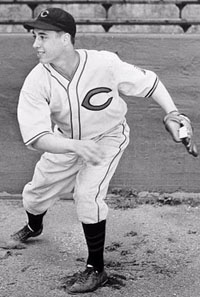
Bob Feller 1936
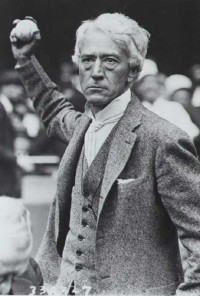
Baseball commissioner Kenesaw Mountain Landis

Rube Waddell
|
|
CONTENTS
Durocher on Mays
Durocher on Rhodes
Scorer Shenanigans
The "Real" 1944 World Series
Wacky Waddell
Lost Home Runs
Scooter's Biggest Embarrassment
Fastest Pitcher Ever
The Fuss Over Feller - I
The Fuss Over Feller - II
Baseball
Vignettes Index
Baseball Page
Golden
Rankings Home |

























